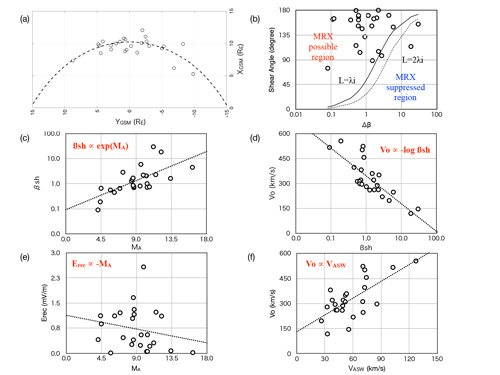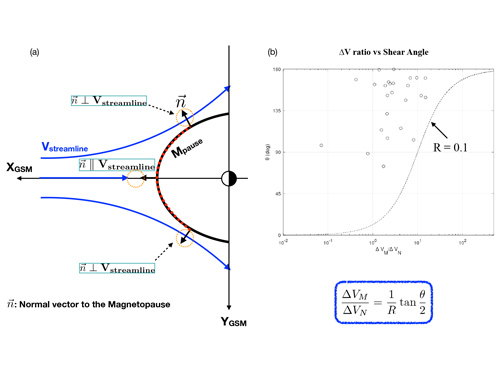
2019 THEMIS SCIENCE NUGGETS
Dayside Magnetopause Reconnection: Its Dependence on Solar Wind and Magnetosheath Conditions
by Daiki Koga
National Institute for Space Research (INPE), São José dos Campos, São Paulo, Brazil
State Key Laboratory of Space Weather, National Space Science Center, Chinese Academy of
Sciences, Beijing, China
Introduction
Magnetic reconnection can rearrange the magnetic topology and rapidly convert magnetic energy into kinetic energy. At the Earth’s dayside magnetopause, magnetic reconnection plays a fundamental role for the mass, momentum, and energy transfer from the solar wind to Earth's magnetosphere and can be an important key factor for space weather predictions. In order to investigate the details of dayside reconnection processes, there have been several studies on the relationship between the solar wind/magnetosheath conditions and Earth's dayside reconnection over decades. Those studies have been focused on the relation between a certain solar wind/magnetosheath parameter (plasma beta and Mach number) and a reconnection-associated parameter at the magnetopause (outflow speeds, reconnection electric fields, and magnetic shear angles as shown in Figure 1) where plasma beta is the ratio of the thermal pressure to the magnetic pressure. In the present study we report that all the past studies can be connected as a sequence of processes, and that the magnetosheath shear flow influences magnetopause reconnection occurrence.
| Figure 1. Magnetic reconnection configuration at the magnetopause: (a) reconnection associated parameters, outflow speed and reconnection electric field, (b) magnetic shear angle. |
Results
25 dayside magnetopause reconnection events observed by THEMIS spacecraft are investigated in order to study dependence on solar wind and magnetosheath conditions. These events were under fairly typical solar wind-Alfvén Mach number conditions. Figure 2a shows satellite positions in the equatorial plane where the dotted curve indicates the nominal position of the magnetopause. A reconnection theory suggests that if the X-line convection speed is much faster than the reconnection outflow speed, the reconnection process is suppressed and this evidence can be seen via the relation between magnetic shear angle and the plasma beta difference Δβ between the magnetosheath and the magnetosphere. In Figure 2b, the magnetic shear angles are plotted against Δβ. Most of the magnetic reconnection events are found above the curves, which means the reconnection process is possible. The magnetosheath plasma beta βsh dependence on the solar wind-Alfvén Mach number MA is shown in Figure 2c. When MA is high, βsh is also high in the semi-log plot (βsh ∝ eMA). The reconnection outflow speed Vo decreases as the magnetosheath plasma beta βsh increases (Figure 2d, Vo ∝-logβsh) and Erec decreases when >MA increases (Figure 2e, Erec ∝ -MA). The reconnection outflow speed is proportional to the solar wind Alfvén speed (Figure 2f, Vo ∝ VAsw).
| Figure 2. (a) The equatorial plane position for the selected magnetopause reconnection events observed by THEMIS, (b) The plasma beta difference between both sides of the magnetopause versus magnetic shear angle, (c) The solar wind-Alfvén Mach number versus magnetosheath plasma beta, (d) The magnetosheath plasma beta versus outflow speed, (e) The solar wind-Alfvén Mach number versus reconnection electric field, and (f) The outflow speed versus solar wind Alfvén speed. |
From the above findings, one could infer the following: When the solar-wind Alfvén speed VAsw is large, one expects a small Alfvén Mach number >MA (=Vsw/VAsw). After the solar wind with small >MA crosses the bow shock, the solar wind plasma in the magnetosheath is less heated, and a small plasma beta βsh is expected in the magnetosheath (or a small Δβ). Also, a higher magnetosheath magnetic field intensity (a small βsh) is expected, which in turn would generate a larger reconnection outflow speed Vo . Then, a large reconnection electric field Erec is obtained, and reconnection would not be suppressed for a large range of magnetic shear angles under the low beta (Δβ) condition.
Next we analyzed the influence of the magnetosheath shear flow on magnetopause reconnection occurrence. Figure 3a shows a schematic for the magnetosheath flow streamline around the magnetopause at the equatorial region. At the magnetopause nose, the streamline and normal direction to the magnetopause are antiparallel in the equatorial plane. At the dawn/dusk flank of the magnetopause, the angle between the streamline and magnetopause normal direction becomes close to 90° . Thus, the reconnection inflow speed normal to the magnetopause is reduced when one moves away from the magnetopause nose and the reconnection process ceases unless there exists a large magnetopause normal motion and plasma instabilities, such as the Kelvin-Helmholtz instability or pressure pulses (also known as jets).
In the present study we adapted the Ma et al. (2016) theoretical expression (the induction equation) to our observations, and we obtained the following expression after rearranging the equation,

|
where ΔVM/ΔVN is the normal (tangential) magnetosheath flow speed, θ is the magnetic shear angle, and R is the reconnection rate. Figure 3b shows the magnetic shear angle from the present observational data as a function of the ΔVM/ΔVN ratio. The dotted curve in the figure is calculated using the above equation where R = 0.1 was used as the reconnection rate where value has been previously confirmed from theoretical and observational evidences. The magnetic shear angle tends to be restricted to a large angle when ΔVM/ΔVN becomes large. This means that, far from the magnetopause nose he magnetosheath flow direction is nearly tangential to the magnetopause and it is almost at right angles with the normal direction to the magnetopause, thus the net reconnection inflow speed from the magnetosheath side is small and reconnection efficiency is largely reduced where reconnection occurs along the magnetopause boundary. As a result, the magnetic shear angle associated with the occurrence of reconnection is dependent on the magnetopause position. Swisdak et al. (2003) suggested that to promote reconnection, the reconnection X-line convection speed should be smaller than the Alfvén speed. For reconnection occurrence in the presence of shear flows, our result suggests that the bulk flow speed ratio ΔVM/ΔVN should be smaller than the Alfvén speed ratio ΔVAM/ΔVAN, where the ration ΔVAM/ΔVAN is the rearranged form of the right-hand side in the above equation.
| Figure 3. (a) Schematic for the magnetosheath flow streamline around the magnetopause at the equatorial region, and (b) The magnetic shear angle θ as a function of the ΔVM/ΔVN ratio where the dotted curve is calculated using the equation with R = 0.1. |
Conclusion
Reconnection-associated parameters, namely, magnetic shear angle θ, outflow speed Vo, and electric field Erec, are affected by several properties of the solar wind and the magnetosheath. The results obtained from our investigation using 25 magnetopause reconnection events showed that the present work can connect all the results reported in past studies. Furthermore, we believe that this is the first time to show a relation between the magnetic shear angle and the magnetosheath flow streamline vector at the equatorial region. This concept could be applied for predicting the effective azimuthal extension of the reconnection X-line, as depicted with a red dotted curve on the magnetopause boundary in Figure 3a.
Reference
Koga, D., Gonzalez, W. D., Souza, V. M., Cardoso, F. R., Wang, C., & Liu, Z. K. (2019). Dayside magnetopause reconnection: Its dependence on solar wind and magnetosheath conditions. Journal of Geophysical Research: Space Physics, 124, 8778– 8787. https://doi.org/10.1029/2019JA026889.Swisdak, M., Rogers, B. N., Drake, J. F., & Shay, M. A. (2003). Diamagnetic suppression of component magnetic reconnection at the magnetopause. Journal of Geophysical Research, 108(A5), 1218. https://doi.org/10.1029/2002JA009726.
Biographical Note
Daiki Koga is a postdoctoral research fellow of China-Brazil Joint Laboratory for Space Weather at NSSC-CAS/INPE in Brazil. His primary research interests are the magnetic reconnection process in space plasma and space weather.
 Please send comments/suggestions to
Emmanuel Masongsong / emasongsong @ igpp.ucla.edu
Please send comments/suggestions to
Emmanuel Masongsong / emasongsong @ igpp.ucla.edu 


